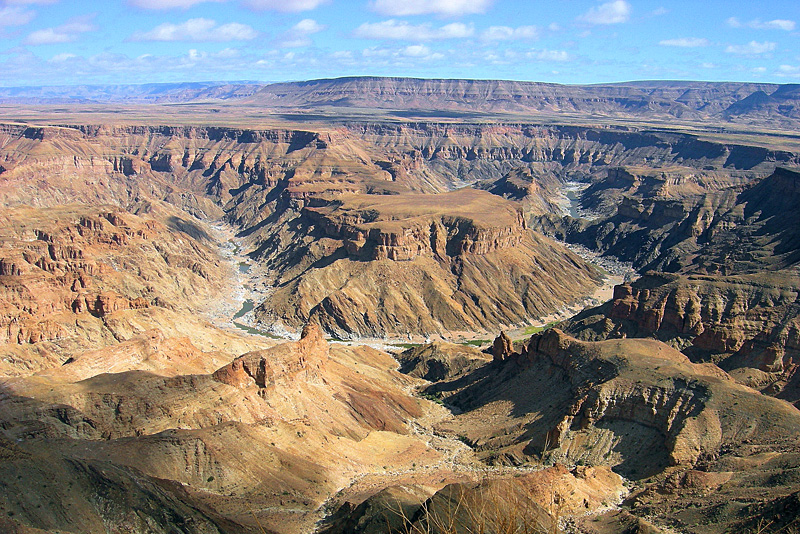Fish River Canyon - Namibia
Fish River Canyon - Namibia
The Fish River (not to be confused with the Great Fish River in South Africa) is the longest river in Namibia with a total length of almost 650 kilometers. Although the distance from the rivers source in the Naukluft Mountains to its outflow into the Orange River in South Africa covers this distance, the river itself is completely blocked after 150km at the Hardap Dam near Mariental. From the dam onwards the river is only fed by tributaries and during the dry winter months the river is nothing but a dry river bed, but the after rainfalls in summer the river can become a raging torrent.
When you look at the raging torrents it is understandable how this river could have cut a 160 km long canyon into the earth, up to 27km wide and at points reaching a depth of almost 550 metres. This is the Fish River Canyon, one of the most impressive natural beauties in the southern part of Namibia. The canyon is regarded by some as the second largest canyon in the world, starting near Seeheim and winding its way through the fissured Koubis massif all the way down to Ai-Ais. The river was not the sole factor in the creation of this spectacular canyon, it is believed that the collapse of the valley bottom due to movements in the earth's crust also played a major role.
The Canyon, which is part of the Ai-Ais Richtersveld Transfrontier Park, has become a very popular destination, with the main hike requiring a good physical health. This hike, which is regarded as one of the most famous hikes in southern Africa, can only be undertaken during the cooler winter months (between May and September), and requires a permit which can be obtained from Namibia Wildlife Resorts in Windhoek. This hike which starts at the rest camp at Hobas is 86 km in length and takes about 5 days. There are however a couple of easier hikes, that are no less beautiful. These scenic hikes are offered by the bordering private parks, the Canyon Nature Park, and the Gondwana Canyon Park.
In the past, trail runners have run the 86 kilometer and this unofficial running eventually evolved into the annual Fish River Canyon Ultra Marathon which held its inaugural race on the 27th of August 2011. Runners are allowed to plan their own routes and take short-cuts through the canyon provided they reach a number of predefined checkpoints. Due to the remoteness of the trail, all competitors are required to be self-sufficient for the duration of the event and are expected to have adequate nutrients as well as the stipulated survival gear. And water is generally sourced from the river which is always close by. An important point to remember for hikers and contestants alike is that the Fish River Canyon is home to the deadly Cape cobra. The neurotoxic venom can result in death or paralysis in humans. Another species of cobra found in the canyon is the black-necked spitting cobra and should also be avoided. Their venom yields are also high and fatal to humans.
From the northern most entrance gate at Hobas rest camp a 10km drive will take visitors to the main viewpoint. Here visitors will find stunning views of the gorge combined with the views of the Nama Karoo to the east of Fish River and the Succulent Karoo to the west of the river. The Succulent Karoo extends into the Sperrgebeit National Park and has over 1600 different plant species, many of them occurring only here and nowhere else. Other outstanding vantage points include Hells Corner and Sulpher Springs.
 Fish River Canyon in Karas, Namibia ©
Fish River Canyon in Karas, Namibia © 
